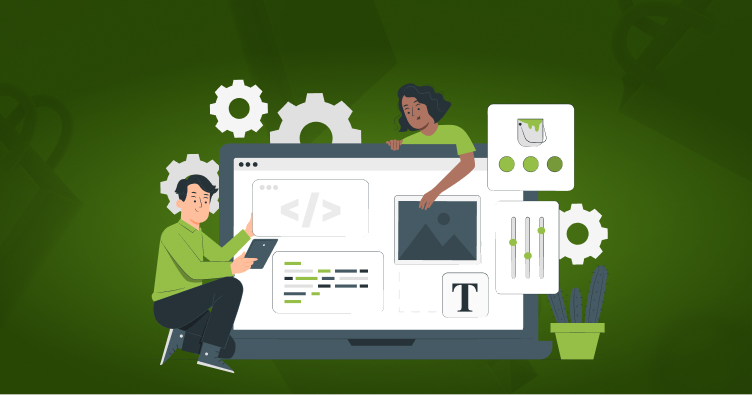How to Build a Shopify App: The Complete Guide 2024
Last Updated | February 12, 2024
Table of Contents
Shopping at your fingertips! How exciting the phrase sounds. Thanks to Shopify apps, these words can become your reality.
Having a customizable app for your Shopify store is not just a technical pursuit anymore but a strategic move toward enhancing user experience. If you are curious about how to build a Shopify app and create a profitable business online, this comprehensive guide acts as your trusted partner.
From initial definitions to insights to step-by-step instructions, this is all you need to know about building a profitable Shopify app.
What Are Shopify Apps?
Let’s start by understanding what Shopify apps are. They are digital tools that can easily blend with a Shopify setup. Each tool is designed to cater to specific business needs. Their features aim to make the respective store stand out with uniqueness.
Want to add value to your store’s inventory management system or provide customers with an unforgettable shopping journey? In that case, there’s a diverse selection of Shopify apps ready to serve you.
Examples of Popular Shopify Apps
Here are some popular Shopify app examples:
Seguno
Seguno helps you build lasting relationships. It is capable of turning seasonal shoppers into loyal brand advocates.
By empowering eCommerce businesses with automation and personalization tools for customer engagement, this app nurtures sequences, loyalty programs, and targeted email campaigns to boost customer lifetime value and repeat orders.
Plug In SEO
Plug In SEO acts as your on-site SEO optimization sidekick. By scanning the Shopify store, it identifies technical issues and broken elements to find and fix ranking issues.
From optimizing product descriptions and page titles to building backlinks and monitoring keyword performance, Plug In SEO supports you with the tools to rank high and attract organic traffic like never before.
Easyship
Easyship simplifies the often-complex world of fulfillment and international shipping. This all-in-one platform connects you with a group of trusted carriers, automates shipping methods, and handles customs clearance for convenient global expansion.
Credit goes to Easyship for handling competitive rates, real-time tracking, and a user-friendly interface, irrespective of where the product is being shipped.
Read Also Advanced Shopify Shipping Apps
When Does It Make Sense to Build a Shopify App for Your Business?
Before you understand how to build a Shopify app, you should learn about the events and ask for such a solution. Here are some scenarios that suggest you need a Shopify app.
- When you have a specific business problem or requirement that cannot be solved using the existing apps on the market.
- When you want to differentiate your store and offer unique features and there is no suitable app available.
- When your store has reached a certain level of success investing in an app can further boost sales and customer satisfaction.
Read Also What is Shopify App Blocks
What to Consider Before You Start
Before learning to build a Shopify app, consider these key factors crucial for a successful venture:
What Is the Purpose of the App?
Identifying the app’s purpose is mandatory before knowing how to create a Shopify app. So, determine the specific problem or need your app can address for Shopify store owners or users. This clarity ensures that the app provides tangible value.
What Type of App Do I Want?
The next step is determining the app type you want to create. It can be a marketing tool, inventory management solution, or a custom storefront enhancer. All of them end up meeting the targeted needs of users. Remember, understanding your app’s category will shape its features and functionality.
How Much Does It Cost to Build a Shopify App?
Calculate the cost of building the Shopify app, as financial considerations are vital. The expenses can be of development, testing, and potential updates. Also, consider ongoing expenses for maintenance and support when working on how to make the Shopify app to ensure a comprehensive budget that aligns with your monetization strategy.
How Hard Is It to Build a Shopify App, and How Long Does It Take?
Lastly, do not forget to analyze the Shopify app requirements. While Shopify’s robust API and documentation facilitate development, understanding the potential challenges is crucial. Development timelines on several factors. For example, app complexity and feature set range from weeks to months. Properly addressing matters lays a solid foundation for a successful Shopify app development process.
How to Build a Shopify App With Node.js
Building a Shopify app with Node.js opens up a world of possibilities! The key steps of how to make a Shopify app with Node.js include:
Setting the Stage
- Clearly define your app’s purpose, target audience, and functionalities. Research existing Shopify apps in your niche to understand the competition and potential gaps.
- Ensure you have Node.js and npm installed. Familiarity with Express.js, web development fundamentals, and API integration best practices is also beneficial.
- Create a free Shopify Partner account to access API documentation, testing tools, and app store publishing features.
Development Journey
- Organize your codebase using appropriate file structures and modules. Express.js can serve as a solid foundation for routing and middleware operations.
- Familiarize yourself with the relevant API endpoints and data structures. Use the official Shopify Node.js API library (shopify-node-api) or third-party libraries to interact with Shopify data.
- Implement secure authentication mechanisms like OAuth 2.0 and handle user authorization with Shopify tokens. Ensure data privacy and encryption best practices are followed.
- Build your app’s user interface using HTML, CSS, and JavaScript web technologies. Consider front-end frameworks like React.js or Vue.js for complex UIs.
Testing and Deployment
- Set up a local development environment to test your app thoroughly before deploying. Utilize the Shopify CLI tools for convenient testing and development workflows.
- Choose a suitable hosting platform for your app. Shopify allows self-hosting or deployment on platforms like Heroku or AWS.
- Prepare your app for submission to the Shopify App Store following their guidelines. Develop a marketing strategy to attract users and stand out in the competitive app landscape.
Exploring the Various Types of Developing Shopify Apps
Shopify Private Apps
You can create a Shopify private app from your account. You must first enable the private application development setting in the Shopify admin panel.
- Log into the Shopify store as the owner of the store.
- Go to Apps from the Shopify Admin.
- Click on the Manage private apps.
- Click on Enable private apps.
- Read the terms and conditions and click the Enable private app development option.
Once enabled, you can now generate credentials for a private app. If you have staff or collaborators, you must give them permission to view or edit the app.
You will then generate the credentials from the Shopify admin panel. The generation of credentials is required so your store can connect with the Shopify app.
- From the Admin panel, go to Apps.
- Click on Manage private apps.
- Click on the Create Private Apps option.
- Add the app’s name and email address to the app data so that Shopify can get in touch with the developer if something goes wrong, such as an alteration to the API chain.
- In the Admin API section, check all areas of the store that Shopify must be able to access.
- Choose Allow this app to access your storefront data with the storefront API to enable the Storefront API. Next, choose the permissions area and adjust the permissions to suit your needs.
- Click on Save when you are done.
Shopify Public Apps
The app will follow the same path as a Shopify private app, but it has more intricacies, so it must be made with certain considerations. You must validate your application ideas by asking yourself these four questions and begin developing if you get answers.
- Is a real-world problem solved by our app?
- Will people pay for a solution to this problem?
- Can we build the application?
- How is the target market trying to solve this problem?
Then, you must start designing your application. You can use Polaris, Shopify store design services, or a private designer who can design your app perfectly. The design is an integral function of an app, so if it is not designed professionally by experts, you will set yourself up for failure.
Design the application for optimal usability, accessibility, and inclusion. Then, you must begin developing the app by having some prerequisites, such as installing npm package managers and reading and understanding backend programming languages such as PHP, JS, and Ruby on Rails.
Embed the app in the platform, built your user interface, access and set up the API, connect the billing API, and introduce code to capture and then react to events.
Then, you must authenticate your app and validate the service using OAuth. Ensure your app is secure by ensuring no data exposure, misconfiguration, injection flaws, or broken access controls.
Shopify Custom App
Building a custom Shopify app can be an exciting way to extend your store’s functionality or create a new revenue stream. But where do you begin? And how to build a Shopify app in a customized way. Here’s a breakdown of the key steps involved:
- Define Your Purpose and Audience:
- What problem are you solving? Is it something many Shopify merchants face, or is it a specific need for your store?
- Who are your ideal users? Understanding their needs, pain points, and technical skills will guide your development decisions.
- Choose the Right App Type:
- Public app: Listed on the Shopify App Store, reaching a wider audience but requiring stricter compliance with Shopify guidelines.
- Custom app: Built specifically for your store or a small group of users, offering more flexibility but limited reach.
- Get Technical:
- Node.js is a popular choice for building Shopify apps thanks to its scalability and robust libraries. Familiarize yourself with Express.js for server-side development and the Shopify Node.js API library for interacting with Shopify data.
- Front-end technologies like HTML, CSS, and JavaScript are essential for user interface building. Consider frameworks like React.js or Vue.js for complex UIs.
- Integrate with Shopify:
- Use the Shopify APIs to access and manipulate data like products, orders, and customers. The Shopify documentation provides detailed information and code examples.
- Implement secure authentication protocols like OAuth 2.0 to ensure data privacy and user authorization.
- Test and Deploy:
- Thoroughly test your app in a local development environment before deploying it to a live server. Shopify CLI tools can streamline testing and development workflows.
- Choose a suitable hosting platform depending on your app’s complexity and traffic needs. Self-hosting, platforms like Heroku, or cloud services like AWS are all viable options.
Custom vs. Public App
Here’s a breakdown of the key differences between a custom and a public Shopify app to help you decide:
Reach and Target Audience
Custom App: It provides limited reach. Plus, it is only accessible to your store or a small group of authorized users. Custom apps are ideal in two situations. You either want to resolve your unique needs or the requirements of a limited group of clients.
Public App: The aim is to provide a wider reach. Shopify merchants are more prone to install public apps because they are suitable for solving common problems many merchants face and generating revenue through subscriptions.
Development and Cost
Custom App: It processes higher development costs and is tailored to your needs.
Public App: Comparatively charges lower upfront development costs if the app addresses a broader audience. However, continuous maintenance and marketing may be crucial expenses.
Flexibility and Control
Custom App: There is flexibility and control over functionalities and features.
Public App: It provides less flexibility as it caters to a wider audience and must adhere to Shopify App Store guidelines.
What Should You Keep In Mind While Building Shopify Apps
Functionality
The fate of successful Shopify app ideas lies in their functionality. It means there should be regular updates and enhancement of features per feedback and market trends. All this is to stay relevant and competitive in the market.
User-friendliness
Another essential step to prioritize is an intuitive interface for your Shopify app. Moreover, ensuring straightforward navigation and workflows is the key. All these allow users to easily understand and conduct usability tests to enhance user-friendliness.
Design
Better engagement rates are directly promotional to visually appealing design. Hence, design has a huge impact on user engagement. By maintaining consistent branding, a clear visual hierarchy, and a clean layout, you can take the app to new heights.
Trust
Establishing trust is yet another element no business should take for granted. Communicating your app’s purpose, functionality, and data-handling practices is paramount. All these should go with Shopify’s security standards and address its issues.
Things to Avoid When Building a Shopify App
Now that you know how to build a Shopify app, avoid these mistakes while you are building your store:
- Not testing your app. The process of Shopify app development does not end upon completion. Instead, Once your app is complete, be sure to test it.
- Using a professional app tester or real-life data is significant to ensure its proper execution.
- Planning at the time of mid-production. Making big plans mid-production could disturb the process and disturb completion. Plus, it can even cost more.
- Incorporating poor quality media. The quality of media assets and inconsistent color schemes can make or break the chain of apps’ success since merchants judge them quite often.
Work With Us to Create the Best Shopify App
Is your Shopify store in need of an upgrade? Connect with folio3 experts to avail professional services to take your store from basic to exceptional. It is high time to craft an online shopping experience that’s uniquely yours!








